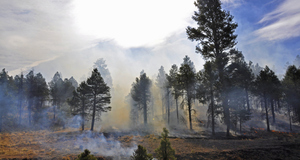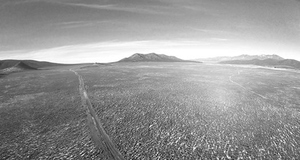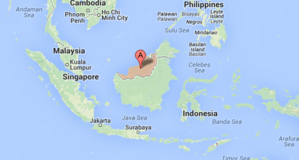From Center for Development and Strategy VOL. 2016 NO. 1Clear-Cutting of the Coastal Temperate Rainforest: A Brief Analysis of Clayoquot SoundEcotourism is a main source of income for communities on northern parts of Vancouver Island (Dodds, 2012). Tourism growth began in the mid 1980s when activities such as whale watching became popular. By the year 2007 approximately 35,000 people visit the area per year. These tourists bring in an economic value of close to $50 million a year for the region (Dodds, 2012). While there is the economic incentive to have tourists in the area, the influx of people also causes issues within the community. A survey was conducted regarding the benefits and effects of tourism in the region, and half of the respondents suggested that tourism was a good livelihood but did not enhance the community, and their sense of place was in jeopardy (Dodds, 2012). There are also potential issues surrounding infrastructure, such as sewage, in the summer months when the population is more than doubled. The small communities directly dump their sewage in the ocean and allow the strong currents to disperse it (Dodds, 2012). In the summer when there is the large influx of people the currents are not always fast or strong enough to dispose of the excess sewage. Another issue with ecotourism is the potential for human and wildlife interactions (Dodds, 2012). There is the potential of feeding from tourists as well as close encounters, especially with bears. When tourists feed the wildlife this creates a situation where wildlife becomes dependent on the food, and are unable to survive on their own (Norden, 2011). Bear interactions typically cause more harm to the bears as they become familiarized with humans and are more likely to become pests. Unfortunately, this typically ends in their destruction by wildlife officials (Norden, 2011). Fishing licenses are important on the West Coast due to the large salmon population of the area. There is also an abundance of aquaculture farms because of the suitable ocean habitat, and ease of access. The Department of Fisheries and Oceans (DFO) are responsible for determining the rate at which fish are caught, which is a vital calculation to ensuring the sustainability of the salmon and other fish in the region (Norden, 2011). Commercial salmon farming, or aquaculture, was valued at $215 million in 2005 with the recreational fishing industry worth nearly $230 million (Norden, 2011). It is clear that salmon fishing is vital to BC as a whole, which provides further incentive to preserve the integrity of the ecosystem. Aquaculture is growing as the demand for seafood has grown, therefore it has the potential to be a key industry in British Columbia's economy. Forestry has the opportunity to contribute to a green economy if improved forest management practices are implemented. Selective logging and longer rotation periods will contribute to more jobs than clear-cutting would, and introduction of value-added products will also help move toward a sustainable forestry sector (Sierra Club, 2009). If the practices, such as variable retention, suggested above were to be implemented, Clayoquot Sound could once again become a viable economy for Vancouver Island and the surrounding areas. Clear-cutting has already been phased out due to government policies and agreements with logging companies, such as MacMillan Bloedel, but clearing practices such as those suggested by Bunnell (2008), need to be implemented to ensure continued sustainability of the forests. Working towards a carbon economy, such as the model suggested by Norden (2011), is essential for the economic wellbeing of the region. If Clayoquot Sound and the neighbouring communities are able to achieve accreditation for their carbon sinks, this could be a profitable endeavour. Finally, ecotourism must continue to grow in a sustainable way. As Dodds (2012) outlined in her surveys, ecotourism must be completed, but the local communities must not feel as if their traditional ways are in jeopardy. The industry cannot grow at an unsustainable pace that does not allow for infrastructure to keep pace. Issues such as sewage and lodging for tourists in the summer months must be acknowledged and addressed if the industry is to continue to grow.UNESCOUnited Nations Education, Scientific, and Cultural Organization (UNESCO) biosphere reserves were first created in 1976 to create a better understanding on how to conserve biodiversity and improve human-environment interactions (Reed and Massie, 2013). Reserves are created due to the sustainability desire of local communities (Reed, 2007). All biosphere reserves are designated to "demonstrate three functions: environmental protection; logistical provisioning for scientific research; and sustainable resource use" (Reed, 2007). These reserves contain three zones: "a core that must be protected by legislation; a buffer where research and recreational uses compatible with ecological protection are allowed; and a transition zone where sustainable resource use is practiced" (Reed, 2007). Clayoquot Sound was designated as a reserve in 2000 to help promote the conservation of biological and cultural diversity; advance sustainable development; and provide support for research, learning, and public education (Tindall, 2013; Reed and Massie, 2013). A biosphere reserve is not a protected area, but is known for being a living laboratory or a learning site. Periodic reviews are conducted for the Clayoquot Sound Biosphere Reserve (Reed and Massie, 2013). Clayoquot Sound receives much media and stakeholder attention due to the large amount of work done by non-profits in the area to raise awareness and encourage involvement in preservation of the region (Reed, 2007). These non-profits, along with government sources and First Nations, have a high level of, involvement in managing Clayoquot Sound (Reed, 2007). The idea that a biosphere reserve is a learning site encourages inclusion of local people in the process of creating a sustainable site (Reed and Massie, 2013). First Nations inclusion in the decision making process is vital for Clayoquot Sound, with the government and First Nations co-managing the area. In general, Clayoquot sound has a strong status of environmental management through work with private, public, and governmental needs to address resource management (Reed, 2007). In her study, Reed found that First Nations of the region were directly involved with resource management of Clayoquot Sound, specifically within a co-management role (2007). First Nations' Involvement in Conservation StrategiesAs the logging disputes arose in the mid-1980s First Nations and NGOs showed their displeasure through non-violent protests. One of the government solutions to the disputes was to set up an Interim Measures Agreement (IMA),between BC and the First Nations, which allowed for the, co-management of the region's resources (Mabee and Hoberg, 2006). The idea of co-management was proposed, so both the First Nations and the BC Government would have a say in how the resources were used (Mabee and Hoberg, 2006). The ultimate goal of co-managing an area is to achieve a state of equality between the two groups (Mabee and Hoberg, 2006). These types of initiatives have been prevalent in BC due to the historic treaties, as outlined above. BC has been a strong example of how First Nations' and Government's ideologies can be aligned. Co-management cannot be seen solely as an environmental issue, for First Nations it is also a socio-political issue (Goetze, 2005). When the agreement toward co-management was created this gave the First Nations of the area more governance over, "their territories and resources, protection of cultural heritage sites, and pursuit of traditional harvesting activities" (Goetze, 2005). Through the negotiation of resource use this requires the government to recognize First Nations' governance structure, where the Chiefs are responsible for land management and distribution (Goetze, 2005). First Nations Chiefs are responsible for dividing their land equitably, and in a manner that will ensure the sustainability of their tribes (Goetze, 2005). The Interim Measures Agreement (IMA) which resulted in co-management acted as a way to address the socio-cultural, political, and legal issues and land rights issues faced by the First Nations communities (Goetze, 2005). The co-management process has been successful for the Nuu-chah-nulth First Nations as it has "advanc[ed] their aspirations concerning political and structural equity, or "systematic change," and the protection and practice of indigenous rights" (Goetze, 2005). British Columbia has the chance to share their successes surrounding co-management with the rest of Canada as well as neighbouring countries with a vested interest in First Nations negotiations. Their successes should be shared as such, and failures should be outlined as a process for improvement. Interim Measures Agreement for Clayoquot SoundThe Interim Measures Agreement (IMA) was a result of the protests in 1993 and negotiated over a period of several months, and was updated in 2008 to extend the co-management practices (Goetze, 2005). The government was initially unwilling to negotiate regarding their involvement with land rights issues with the Nuu-chah-nulth Nation (Goetze, 2005). The persistence in negotiating allowed for the IMA to recognize many key political claims of the Nuu-chah-nulth that are closely related to resource management, their governance structure, Chief authority, and the relationship between the Nuu-chah-nulth governance and the Government of BC (Goetze, 2005). The agreement gave the Nuu-chah-nulth much control of the natural resources of their home (Magnusson and Shaw, 2003). The IMA agreements around resource management led to the formation of the Central Region Board and the Scientific Panel, which included equal representation from First Nations and BC Government (BC, Government, 1994; Magnusson and Shaw, 2003). The Board provided cooperative management of the terrestrial and marine resources, except for ocean fisheries, in Clayoquot Sound (BC Government, 1994). The unique feature of the board was that a double majority was required for any voting matters. This meant that a majority from the government representatives and the Nuu-chah-nulth representatives was required (Goetze, 2005). The IMA give Nuu-chah-nulth the position of "co-managers tangible, determinative authority to make decisions about resource use in Clayoquot Sound" (Goetze, 2005). Finally, the IMA provides a sense of positive interaction between Nuu-chah-nulth, the BC Government, and local communities (Goetze, 2005). ConclusionsThe history of Clayoquot Sound has been varied and shaped through social, political, and environmental tensions. In the1970s and 1980s when the BC Government was looking to expand their economic activity there was little regard for the environmental goods and services provided from the coastal temperate rainforest. The biodiversity and range of natural habitat of the coastal temperate rainforest is vast, and becoming increasingly rare. Steps must be made to ensure that the area is protected from further damage that arises through clear-cutting of an area. The protests in 1993 helped bring awareness to the issues facing the area, and non-profit, community, and governmental involvement and interest continued after the UNESCO biosphere reserve designation in 2000. This also allotted the area as a protected zone, showing British Columbia's dedication to protecting their unique ecosystem and its biodiversity. Alternative options have been implemented to continue to obtain economic benefits from Clayoquot Sound. Utilizing the old growth forest is especially beneficial as a carbon offsetting tool as the dense and large old trees are excellent carbon sinks. Ecotourism is also very important to the region, as it boasts a mild climate, diverse scenery, and many environmental activities that are attractive to tourists. While the region is very small, it benefits from thousands of tourists a year bringing in millions of dollars to the local communities. Fishing and hunting are also popular activities, although not as economically profitable as carbon offsetting or ecotourism. First Nations' involvement in the natural resource management process has been continuous, with the Nuu-chah-nulth community being the most involved due to their close connections to Clayoquot Sound through traditional territory and subsistence activity. A significant achievement for the Government of BC and the First Nations was the agreement that allowed for a co-management of the land in and surrounding Clayoquot Sound. This was significant due to the required levels of cooperation, allowing both parties to have an equal say in the management of the ecological goods and services of the area. Initiatives similar to this should be implemented throughout Canada, with the BC Government providing relevant information for the other Provincial governments. Climate change has the potential to significantly impact the biodiversity of Clayoquot Sound. Climate models project a large increase in mean annual temperature, and increase of approximately 100 additional millimetres of rain per year, and a decrease in annual precipitation in the form of snow. The compilation of the effects of climate change could be potentially very damaging for the coastal temperate rainforest; therefore, this area must continue to be protected by First Nations, non-profits, and the Provincial and Federal Governments. The case study of Clayoquot Sound shows that environmental awareness about a region or specific issue is key in helping work towards preservation. When people are able to come together in peaceful protest many new agreements and regulations can be made to solve the problem. It is vital to include First Nations in the recommendation proves for ecological goods and services as they have lived off the land for much longer than we have, and are able to sustainably manage the resources. Overall, British Columbia is doing a commendable job in protecting the coastal temperate rainforest but needs to ensure future commitments are set and followed in order to preserve the forest. As the last remaining intact coastal temperate rainforest it is vital that the area is kept pristine and used as a strong example of successful environmental policies and sustainable standards. ReferencesBritish Columbia Government (1994). Interim Measures Agreement on Clayoquot Sound between the Central Region Chiefs of the NuuSchahSnulth Tribal Council and the Province of British Columbia. Victoria: Ministry of Aboriginal Affairs. British Columbia Government (2003). British Columbia's Forests: A Geographical Snapshot. National Library of Canada Cataloguing in Publication Data. British Columbia Ministry of Forests, Lands and Natural Resources Operations (N.D.). Clayoquot Sound. Retrieved From: http://www2.gov.bc.ca. [Accessed on: 1 December 2015]. British Columbia Treaty, (2009). Six-Stage Treaty Process. Retrieved From: http://www.bctreaty.net/files/sixstages-13.php. [Accessed on: 2 December 2015]. Bunnell, F. L. (2008). Indicators for sustaining biological diversity in Canada's most controversial, forest type-coastal temperate rainforest. Ecological Indicators, 8(2), 149-157. 2006.11.007 Bunnell F.L., Dunsworth G.B. (Eds.) (2009). Forestry and biodiversity: Learning how to sustain biodiversity in managed forests. Vancouver: UBC Press. Dodds, R. (2012). Sustainable tourism: A hope or a necessity?,the case of Tofino, British, Columbia, Canada. Journal of Sustainable Development, 5(5), 54-64. Goetze, T. C. (2005). Empowered co-management: Towards power-sharing and indigenous, rights in clayoquot sound, BC. Anthropologica, 47(2), 247-265. Hoberg, G. & Morawski, E. (1997). Policy change through sector intersection: Forest and, aboriginal policy in clayoquot sound. Canadian Public Administration, 40(3), 387-414. 1997.01516. Lavallee, L. & Suedfeld, P. (1997). Conflict in clayoquot sound: Using thematic content analysis, to understand psychological aspects of environmental controversy. Canadian Journal of Behavioural Science/Revue Canadienne Des Sciences Du Comportement, 29(3), 195-210. Mabee, H. S. & Hoberg, G. (2006). Equal partners?,assessing comanagement of forest, resources in clayoquot sound. Society & Natural Resources, 19(10), 875-888. Magnusson W., Shaw K. (Eds.) (2003). A political space: Reading the global through Clayoquot Sound. Montreal: McGill-Queen's University Press. Natural Resources Defense Council (NRDC) (N.D.). What is Clearcutting? Retrieved from: http://www.nrdc.org/land/forests/fcut.asp. [Accessed on: 1 December 2015]. Norden, A. (2011). In Tansey J., Sustainable Prosperity., University of British Columbia. and, Canadian Electronic Library (Firm). (Eds.), Great bear markets: The interface of finance, forestry and conservation in BC s great bear rainforest. Vancouver, B.C.: ISIS Research, Centre. Pacific Carbon Trust (2014). Annual Report 2013/2014. Retrieved from: http://www.pacificcarbontrust.com. [Accessed on: 25 November 2015]. Price, K., Roburn, A. & MacKinnon, A. (2009). Ecosystem-based management in the great bear, rainforest. Forest Ecology and Management, 258(4), 495-503. 2008.10.010 Reed, M. G. (2007). Uneven environmental management: A canadian perspective. Environmental Management, 39(1), 30-49. Reed, M. & Massie, M. (2013). Embracing ecological learning and social learning: UNESCO, biosphere reserves as exemplars of changing conservation practices. Conservation and Society, 11(4), 391-405. Shanley, C., et al. (2015). Climate change implications in the northern coastal temperate, rainforest of North America. Climatic Change, 130(2), 155-170. Sierra Club BC (2009). State of British Columbia's Coastal Rainforest: Mapping the Gaps for Ecological Health and Climate Protection. Retrieved from: www.sierraclub.ca/bc. [Accessed on: 15 November 2015]. Tindall, David (2013, August 12). Twenty Years After the Protest, What We Learned from, Clayoquot Sound. The Globe and Mail. Retrieved from: http://www.theglobeandmail.com, [Accessed on: 7 October 2015]. Walter P.,(2007). Adult learning in new social movements: Environmental protest and the struggle for the Clayoquot Sound rainforest. Adult Education Quarterly, 57(3) 248-263. Suggested Reading from Inquiries Journal
Inquiries Journal provides undergraduate and graduate students around the world a platform for the wide dissemination of academic work over a range of core disciplines. Representing the work of students from hundreds of institutions around the globe, Inquiries Journal's large database of academic articles is completely free. Learn more | Blog | Submit Latest in Environmental Studies |



















